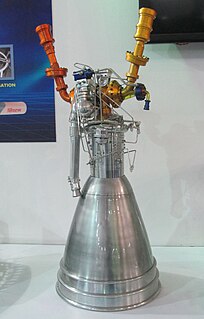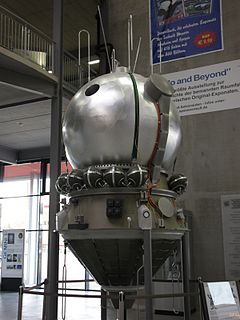The Long March 1D was a member of China's Long March rocket family. During the 1990s CALT developed an improved version of the DF-4 to test the reentry vehicle warheads of the DF-31. They took advantage of this development and offered it as the Long March 1D for commercial application. The modifications included:

Long March 5, or Changzheng 5 (CZ-5), and also by its nickname "Pang-Wu", is a Chinese heavy-lift launch vehicle developed by the China Academy of Launch Vehicle Technology (CALT). It is the first Chinese launch vehicle designed to use exclusively non-hypergolic liquid propellants. It is the fifth iteration of the Long March rocket family.

The YF-100 is a Chinese liquid rocket engine burning LOX and kerosene in an oxidizer-rich staged combustion cycle.

The Vikas is a family of liquid fuelled rocket engines conceptualized and designed by the Liquid Propulsion Systems Centre in the 1970s. The design was based on the licensed version of the Viking engine with the chemical pressurisation system. The early production Vikas engines used some imported French components which were later replaced by domestically produced equivalents. It is used in the Polar Satellite Launch Vehicle (PSLV) and the Geosynchronous Satellite Launch Vehicle (GSLV) series of expendable launch vehicles for space launch use.

The Long March 6 or Chang Zheng 6 as in pinyin, abbreviated LM 6 for export or CZ 6 within China, is a Chinese liquid-fuelled launch vehicle of the Long March family, which was developed by the China Aerospace Science and Technology Corporation (CASC) and the Shanghai Academy of Spaceflight Technology (SAST). The rocket was developed in the 2000s, and made its maiden flight in 2015. As one of the new generation rocket family, the Long March 6 was designed to be a light capacity, "high-speed response" rocket, complementing the heavy lift Long March 5 and the mid-heavy lift Long March 7 rocket families. It is capable of placing at least 1,000 kg (2,200 lb) of payload into a Sun-synchronous orbit. The first stage of the Long March 6 was derived from the booster rockets being developed for the Long March 5 rocket. It is powered by a YF-100 engine, which generates 1,340 kN (300,000 lbf) of thrust from burning kerosene and LOX as rocket fuel and oxidiser. This was the first flight of the new engine design.
The Long March 7, or Chang Zheng 7 in pinyin, abbreviated LM-7 for export or CZ-7 within China, originally Long March 2F/H or Chang Zheng 2F/H, nicknamed Bingjian, is a Chinese liquid-fuelled launch vehicle of the Long March family, developed by the China Aerospace Science and Technology Corporation (CAST). It made its inaugural flight on 25 June 2016.
The RD-120 is a liquid upper stage rocket engine burning RG-1 and LOX in an oxidizer rich staged combustion cycle with an O/F ratio of 2.6. It is used in the second stage of the Zenit family of launch vehicles. It has a single, fixed combustion chamber and thus on the Zenit it is paired with the RD-8 vernier engine. The engine has been developed from 1976 to 1985 by NPO Energomash with V.P. Radovsky leading the development. It is manufactured by, among others, Yuzhmash in Ukraine.
The YF-115 is a Chinese liquid rocket engine burning LOX and kerosene in an oxidizer-rich staged combustion cycle. A high efficiency/high thrust environmental friendly rocket engine was always an objective within Programme 863. Development began in the 2000s, along with its sibling, the bigger YF-100, which would power the LM-5, LM-6 and LM-7 boosters and first stages. Testing was directed by the China National Space Administration (CNSA) commencing in 2005. Development works are mainly carried out by the Xi'an Aerospace Propulsion Institute. It will be used as upper stage engine for China's next generation of medium and light environmental-friendly launch vehicles, namely the Long March 6 and the Long March 7. During early 2012, the engine system successfully passed vacuum testing. It is China's first upper stage rocket engine to adopt the staged-combustion cycle.
The YF-23 is a liquid rocket vernier engine, burning N2O4 and UDMH. It is used in along the YF-22 to form the YF-24 and YF-25 propulsion modules.
The FG-46 is a Chinese spin stabilized solid rocket motor burning HTPB. It was developed by China Hexi Chemical and Machinery Corporation for use in the Long March 2E on GTO missions. It first flew as a prototype SPTS-M14 on July 16, 1990 on the Badr A mission. It had its first commercial mission orbiting the AsiaSat 2 on November 28, 1995 and exactly one month later, on December 28 its second and last mission for EchoStar 1.
The CTS is an upper stage developed by the China Academy of Launch Vehicle Technology (CALT) to improve the performance of the Long March 2C to high LEO missions like SSO. The two stage LM-2 delivers the payload and stage to an elliptical orbit with the desired apogee and the CTS points the stack in the direction of the correct vector and activates the solid rocket motor (SRM) main engine to circularize it. It then dispenses the spacecraft and does a passivisation procedure.
The FG-47 is a Chinese solid rocket motor burning HTPB. It was developed by China Hexi Chemical and Machinery Corporation for use in the Long March 2C SD/CTS/SMA third stage. It had its inaugural flight on the Iridium-MFS demonstration mission on September 1, 1997.

The S5.4, was a Russian liquid rocket engine burning TG-02 and AK20F in the gas generator cycle. It was originally used as the braking (deorbit) engine of the Vostok, Voskhod, and Zenit spacecraft, which later switched to solid engines.
The YF-1 was a Chinese liquid rocket engine burning N2O4 and UDMH in a gas generator cycle. It is a basic engine which when mounted in a four engine module forms the YF-2. It was used as the basis for developing a high altitude version known as the YF-3.
The FG-36 was a Chinese spin stabilized apogee kick motor burning HTPB. It was developed by China Hexi Chemical and Machinery Corporation for use in the Fengyun 2 satellite bus for insertion into GSO orbit.

The A.M. Isayev Chemical Engineering Design Bureau, also known as KB KhimMash or just KBKhM, is a Russian rocket engine design and manufacturing company. It is located in the city of Korolyov. It started as the OKB-2 division of the NII-88 research institute, where A.Isaev directed the development of liquid rocket engines for ballistic missile submarines.
The RD-810 (РД-810) is a Ukrainian liquid propellant rocket engine burning LOX and Kerosene (RG-1) in a staged combustion cycle. It has a single combustion chamber that provides thrust vector control by gimbaling of the nozzle in two axis by +/- 8°. It is being designed in Ukraine by Yuzhnoye Design Bureau for the prospective first stage propulsion of the Mayak rocket family.
The Unified Launch Vehicle (ULV) is a family of modular expendable launch vehicles, currently under development by the Indian Space Research Organisation (ISRO). This vehicle is designed to replace the PSLV, GSLV Mk I/II and GSLV Mk III with a single family of launchers.
The RD-0255 is a propulsion module composed of an RD-0256 main engine and a RD-0257 vernier engine. Both are liquid rocket engine, burning UDMH in N2O4. The RD-0256 main engine operates in the oxidizer rich staged combustion cycle, while the vernier RD-0257 uses the simpler gas generator cycle. It was used on the R-36MUTTKh (GRAU:15A18) and R-36M2 (GRAU:15A18M). Subsequently, it has been in the Dnepr second stage and as of 2016 it is still in active service.
The RD-801 is a Ukrainian liquid propellant rocket engine burning LOX and Kerosene (RG-1) in a staged combustion cycle. It has a single combustion chamber that provides thrust vector control by gimbaling of the nozzle in two axis by +/- 6°. It is being designed in Ukraine by Yuzhnoye Design Bureau for the prospective first stage propulsion of the Mayak rocket family.







